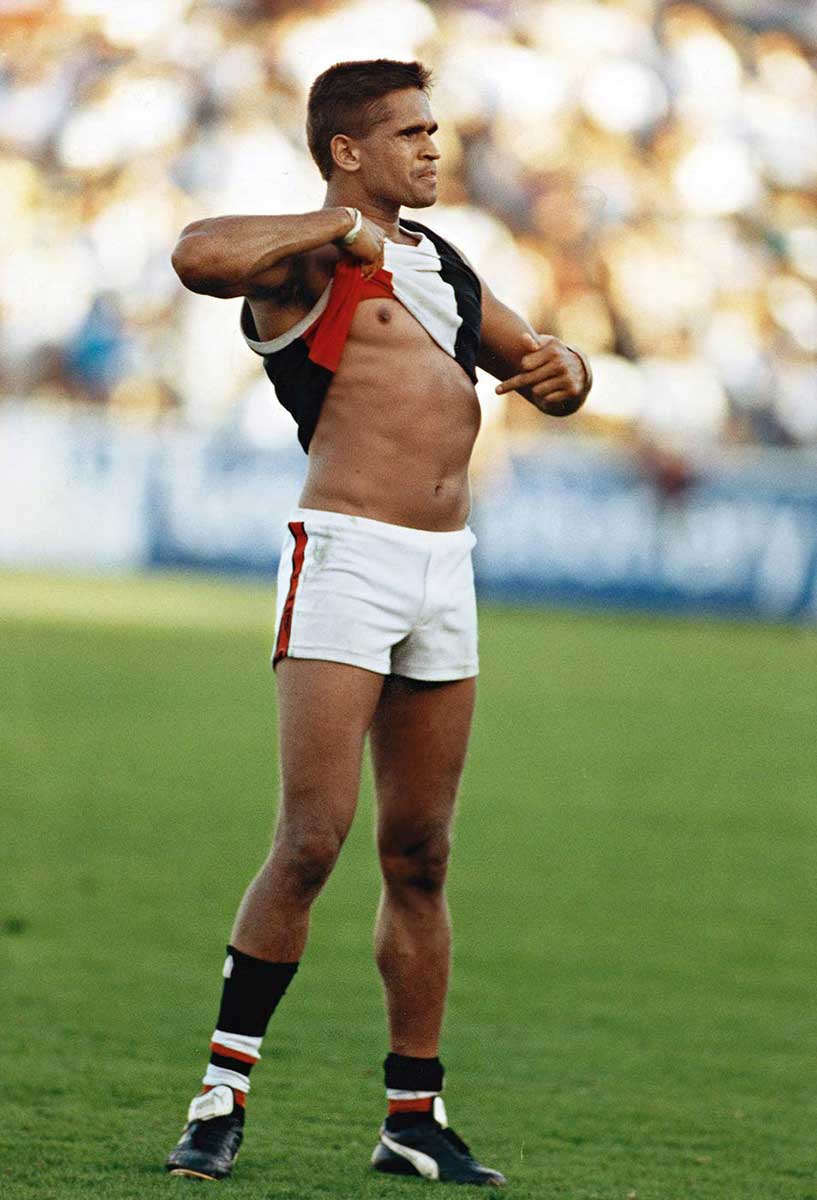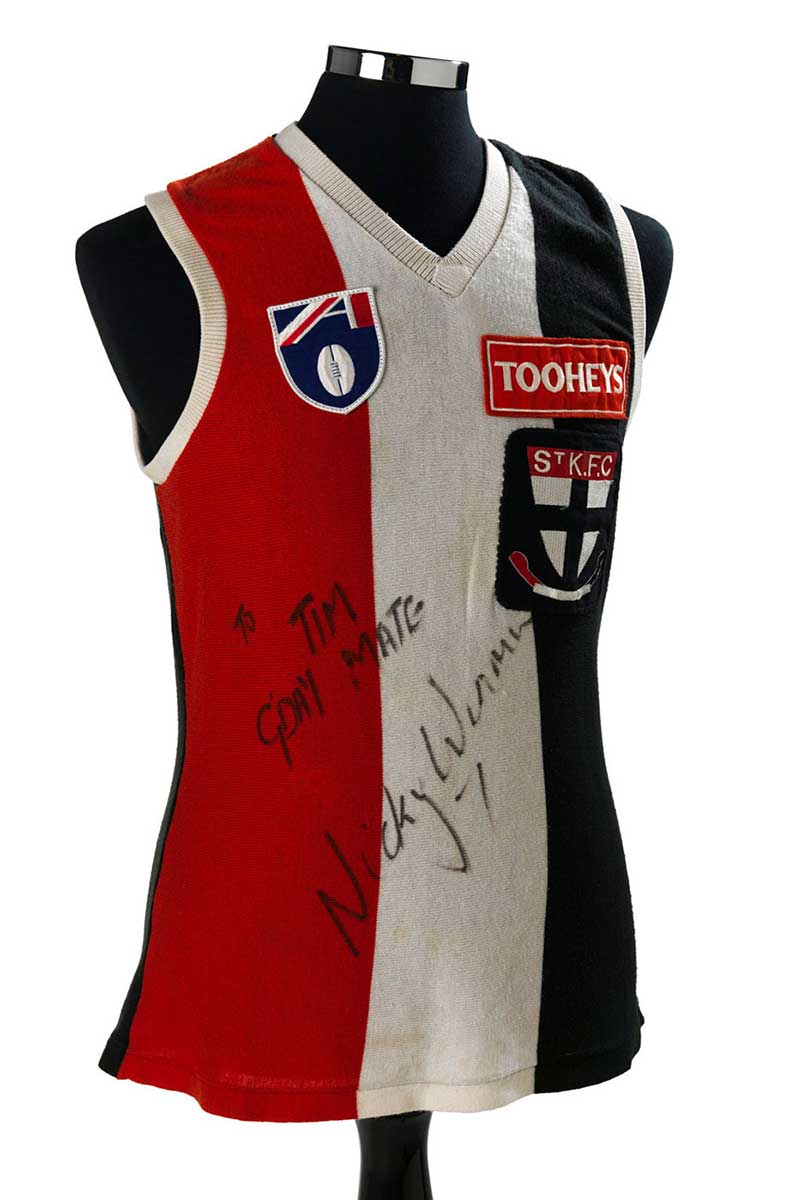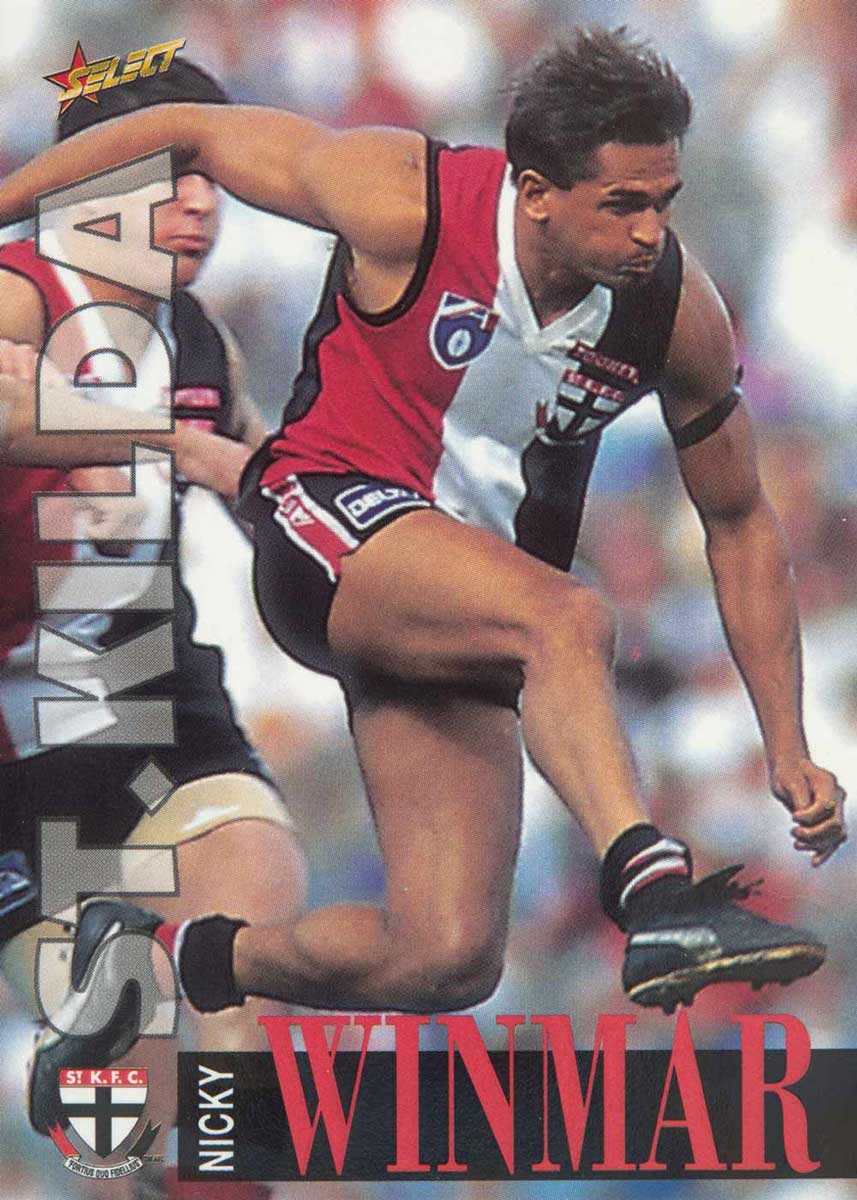
On 17 April 1993 Aboriginal Australian Football League (AFL) player Nicky Winmar stood defiantly in front of opposition spectators who had been hurling racial abuse at him.
He lifted his jersey and pointed at his skin, shouting, ‘I’m black and I’m proud to be black.'
Aboriginal and Torres Strait Islander AFL players had endured racial abuse on the field from spectators and other players.
Winmar’s stand, which was captured in iconic photographs, opened the way to a code of conduct that was the first of its kind in Australia.
Aboriginal AFL player Adam Goodes on Nicky Winmar’s gesture, 2013:
It’s something that stands in history, which proves that you can call me all the things you want, you can discriminate against me, say all these things, but I’m still going to be black, I’m still going to be proud.
That’s exactly what the photo symbolises to me. Even today, 20 years later, it highlights how every Indigenous person should feel about their heritage.
Racism in Australian Rules football
Caroline Wilson was the first journalist to investigate racism in the AFL. In an article written in August 1991, she revealed that Aboriginal and Torres Strait Islander players across the league were racially abused during games and some had received death threats.
However, it wasn’t until early April 1993 that someone inside the AFL administration made the issue public.
David Shaw, president of the Essendon Football Club, in his debut presidential speech, condemned racial abuse within the game, saying, ‘… we have four or five Aboriginal guys and they cop heaps … It’s quite obvious they [the offenders] can’t beat them on their own merits, so they have to try other tactics to counter them’.

St Kilda versus Collingwood
On Saturday 17 April 1993 St Kilda faced Collingwood at the Magpies’ (Collingwood) home ground of Victoria Park.
The Saints had beaten the Magpies in the finals the year before so there was animosity, but St Kilda had not defeated Collingwood at Victoria Park since 1976.
In the warm-up before the game, Gilbert McAdam and Nicky Winmar received withering racial abuse from the crowd.
McAdam grabbed Winmar and said, ‘Bro, we have to do something today. We have got to make a statement. We’ll show this mob, we’ll make them quiet today.'
It was a hard-fought game with both teams leading at different times. The deciding factor was the performance of St Kilda’s Indigenous players, with Winmar and McAdam named ‘best on the ground’.
As the siren sounded, Winmar was standing near the Collingwood cheer squad. Some Magpies’ fans were not gracious in defeat and continued to hurl abuse.
Winmar lingered, raising his hands in victory towards the hostile spectators and then, as if he had heard something specific from the crowd, he looked at them, raised his jumper, pointed at his skin and said, ‘I’m black and I’m proud to be black.'
Reaction to Winmar's stand
The pictures, which were taken from different angles by photographers Wayne Ludbey and John Feder, appeared in the Sunday Age and Sunday Herald Sun respectively. Both photographers had to fight with their editors to get the photos the prominence they deserved.
On the day, there was not much discussion about the images but by Tuesday, everyone was talking about it. An editorial in The Age read, ‘There is no place for racism in football and the AFL must do everything in its power to make sure players and if possible, spectators understand this.'
The following weekend the Collingwood president, Allan McAlister, appeared on television to assure Victorians that the Magpies were not a racist club.
However, he finished by saying that Collingwood did not have an issue with Indigenous Australians, ‘... as long as they conduct themselves like white people, well, off the field, everyone will admire and respect them’.
McAlister’s comments did nothing to alleviate the situation and controversy simmered throughout the remainder of the season, but by the end of 1993 the AFL promised to establish a code of conduct for players and teams.

A draft version of the code was ready by the start of the 1995 season, although some Aboriginal and Torres Strait Islander players believed the AFL was moving too slowly.
Essendon player Michael Long brought things to a head in April 1995, after being racially abused during a game by Collingwood’s Damian Monkhorst. Long had had enough and made a formal complaint to the AFL.
The league brought the players together and mediated an apology but Long was unhappy, claiming he had been gagged by the league. He called for support from Indigenous players and together they called for institutional change.
The AFL responded by introducing an education campaign, ‘Racism: The Game is Up’, and told their umpires to start reporting racial abuse. On 12 May 1995 the first case of on-field racial abuse was reported. The stage was set for the implementation of the code of conduct.
Rule 30 to combat racial and religious vilification
On 30 June 1995 ‘Rule 30: A rule to combat racial and religious vilification’ was instituted.
Rule 30 stated that:
No player … shall act towards or speak to any other person in a manner, or engage in any other conduct which threatens, disparages, vilifies or insults another person … on the basis of that person’s race, religion, colour, descent or national or ethnic origin.
The role of umpires in reporting incidents of racial abuse was emphasised and clubs were liable for fines of up to $50,000.
The league also introduced strategies to encourage football development in Indigenous communities and to fund AFL Aboriginal liaison officers in each state.
Significance of Nicky Winmar's stand against racism
Winmar’s gesture ignited a national discussion on racism in sport. The instigation of Rule 30 was the first time that racist abuse was officially prohibited within a sport. The ruling sent a message that racism would no longer be an acceptable part of the game or the culture around it.
According to an Australian Human Rights Commission report in 2007, the AFL led the way in Australian sports in trying to engage with ethnic and Indigenous groups.
Racism persists in the game, as demonstrated in 2013 when Sydney Swans player Adam Goodes was vilified by a 13-year-old spectator. In 2023, Western Bulldogs player Jamarra Ugle-Hagan lifted his shirt in a gesture similar to Winmar, after being racially abused by a fan at a game and on social media.
In our collection
You may also like
Further reading
Matthew Klugman and Gary Osmond, Black and Proud: The Story of an Iconic AFL Photo, New South Publishing, Sydney, 2013.
Colin Tatz, Obstacle Race: Aborigines in Sport, UNSW Press, Sydney, 1995.